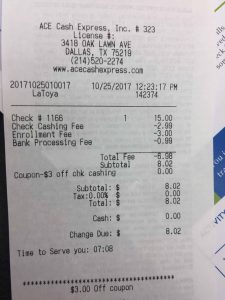At at the end of every month, are you always wondering “Where did all the cash go?” Taxes and credit card processing fees get a lot of attention as eating into our profit, but many small business owners overlook how other fees and the cost of doing business can quickly add up and eat into their profits. If at the end of the month, you’re not sure why you don’t have as much money leftover in the bank — keep reading to learn about the overlooked, hidden costs to running your business.

Take a closer look to find hidden fees.
Seven Hidden Costs to Running a Business
#1 – Opening bank accounts with maintenance fees
Often, I find people opening their business bank accounts with where they have their personal accounts. While this may be convenient, opening accounts with the bigger, national banks like Bank of America, Wells Fargo, and Chase, may include account maintenance fees that can range around $10 – $30 per month unless you meet certain requirements. The requirements to avoid the monthly maintenance fees are generally higher than I see most small business owners able to maintain each month, including spending at least $250 in net new purchases using the bank’s business debit or credit card, or maintaining a high average monthly balance of $5,000 or more.
Example: If you are being charged $14 per month for a Bank of America Business Fundamentals checking account that you can’t meet monthly requirements to waive:
$14 fee per month x 12 months = $168 per year
In five years, that $168 fee per year x 5 = $840 over five years.
The banks that tend to more fee-friendly to small business owners are the smaller, community banks, who often have at least one type of free checking and savings accounts for small business owners with often no minimum opening deposit. The community and online banks where you can avoid and eliminate account maintenance fees, monthly balance requirements, and monthly transaction fees include First Horizon Bank, First Citizens, and Capital One.
#2 – Signing up for a credit card rewards program
The cash-back and travel perks can be great motivators to signing up for a credit card program, but make sure you read the fine print and know what the annual fees are for the card. They usually waive the annual fee for the first year, but after that the fees can range between $95 – $295.
Example: If you are being charged $95 per year for a Chase Ink Business Preferred business credit card, in five years you will have paid:
$95 fee per year x 5 = $475 over 5 years
Recommendation: If you’re set on using a certain credit card that has an annual fee, make sure you budget, save, and have the money when those annual fees come due. Otherwise, switch to a card that has a great sign up bonus and no annual fee like Chase Ink Business Unlimited.
#3 – Paying credit card bills late
Forgetting to pay your credit card bill on time or not being able to pay your balance because you are waiting for your customers to pay their invoices can really add up. Late fees range typically around $39, and remember – this is just the penalty for paying late and does not include the interest that starts accruing the day you are late.
Example: If you are late in paying your credit card bills about six times a year, in five years you will have paid:
$39 x 6 late fees x 5 years = $1,170 over 5 years
Recommendation: Set-up automatic payments or recurring appointment reminder for your credit card due dates. Also, re-evaluate your own invoicing and billing cycle if you need cash from your customers sooner than they’ve been paying.
#4 – Over-drafting checking account
When there are insufficient funds in the checking account and an unexpected bill gets auto-drafted, the banks charge overdraft fees. If you have other accounts like a savings account at the bank, they may take funds from your other account to pay the difference. These can really add up when you don’t keep a close eye on your account for days, weeks or months at a time, as you can get charged each time the bank pays an overdraft. There may be a maximum in overdraft fees charged per day, but having a good handle on when your expenses are auto-billed can make a difference in your ability to keep your hard-earned cash.
Example: If you are charged $37 for each overdraft at First Horizon Bank and you had five expenses that were auto-billed before you realized your account was low, you will have paid:
$37 per overdraft x 5 = $185 in overdraft fees
#5 – Paying higher fees to collect money from customers and clients
What criteria did you use when selecting your payment processing system for charging customers and clients? Many business owners go with the one that they hear others use, but may not have taken the time to evaluate how they charge for their products and services. The most commonly known payment systems include Square and PayPal.
Did You Know: the credit card and payment processing fees tend to be higher when:
- Manually entering credit card number vs. swiping credit card with a card reader
- Emailing an invoice for payment vs. swiping credit card with a card reader
- Charging with American Express vs. Visa and MasterCard
Recommendation: If you’re taking payments in-person, it’s better to swipe a credit card than to manually enter the credit card number. Make sure you use a payment processing system that has hardware to allow you to swipe credit cards.
#6 – Forgetting to pay annual report and legal entity fees
When you register your business as a legal entity with the state, there are annual report fillings and fees that are due. While it is called an annual report, in some states, an LLC annual report may not be due every year. For example, some states, such as Iowa and Indiana, only require that LLCs file every other year. Pennsylvania only requires every 10 years. Then some states like North Carolina, Florida, and Delaware mandate it to be filed every year.
If you forget and are late paying the annual fee for your business, your business could be put on administrative hold by your state, and you may lose all legal protection until the business is re-instated. Some states have a steep fine – Did you know that in the state of Florida, if you are late paying your annual report filing fee, the late fee is $400?!?
Recommendation: Create a recurring meeting invite in your calendar for when your annual filings are due and pay on time to avoid late filing fees and reinstatement fees.
#7 – Cashing check at a non-traditional bank
During a real-life financial experiment called FinX put on by the Center for Financial Services Innovation (CFSI) and sponsored by the Metlife Foundation, I recently worked with a team to see a day-in-a-life of someone who was unbanked. Unbanked are people who do not have their own bank accounts and rely on alternative financial services means to get cash.
This experience was eye-opening and shocking to learn how much in fees that these non-traditional financial institutions charge.
The Challenge – Two of my teammates were given real checks made out to their names – 1) payroll check from a part-time job and 2) a personal check from a less formal employment. We were given activities to perform, included cashing out the checks and taking care of some everyday expenses. We were to assume that we didn’t have a traditional bank account, and could not cash out our checks and perform any of the tasks at a bank like Bank of America, Chase, or Wells Fargo that we already had accounts with.
We went to an ACE Cash Express to cash out the two checks and were shocked to learn we had paid 56.5% in fees!
- Paid 10% in fees for cashing out the $70 payroll check. The fee to cash out the $70 check was $6.98.
- Paid 46.5% in fees for cashing out $15 personal check. The fee to cash out the $15 check was also $6.98. That’s almost half of the check went to fees!?!

Almost half of the check gone to fees!
Recommendation: If you are using a non-traditional financial institution, please look into community banks or online banks that have free and low-cost business checking and savings accounts to help small business owners.
Summary:
If you’re always wondering why you don’t seem to have a lot of money at the end of the business month, take this list and eliminate any of these additional fees. Remember, these fees are taken out AFTER you’ve already paid taxes, so taking time to plan and avoid these fees can mean improving your bottom line and more cash for you and the business.



